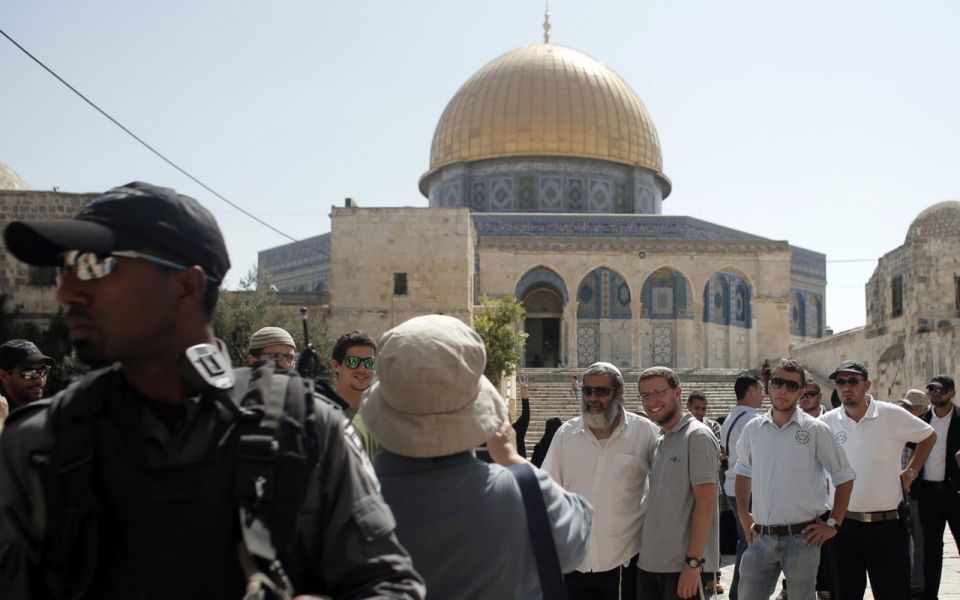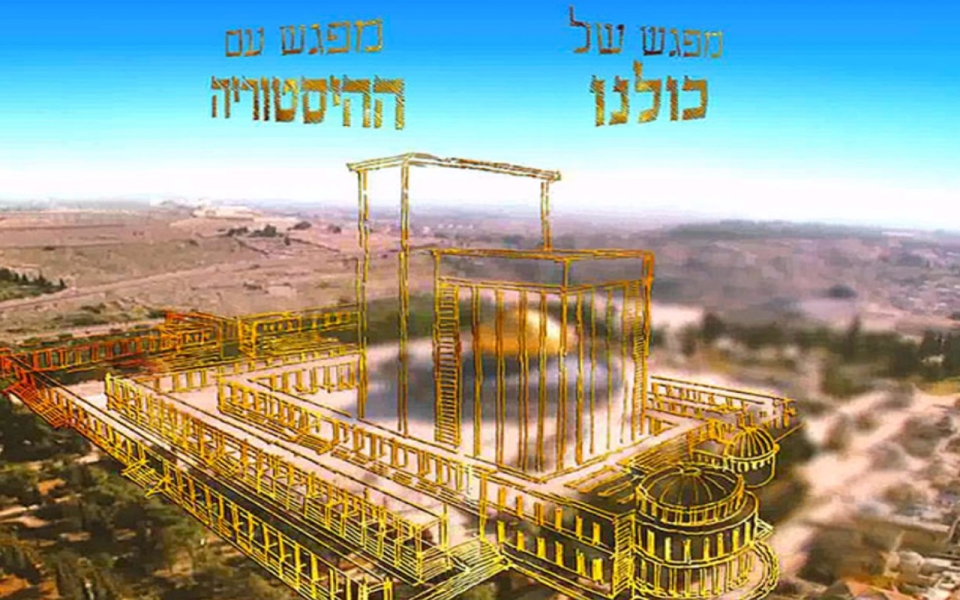
When Israeli military chief Moshe Dayan arrived at the Islamic holy sites atop Jerusalem's Temple Mount that his forces had captured in the war of June 1967, he immediately ordered the removal of an Israeli flag that had just been hoisted over the Dome of the Rock. Dayan recognized the inflammatory situation created by Israel's military occupation of the single most contested piece of real estate in the region, and as a result, established an enduring status quo atop the sacred platform known to Jews as the Temple Mount and to Muslims as the Noble Sanctuary, from which the Prophet Muhammad is believed to have ascended to heaven.
Although Israel has since retained security control of the area — and frequently cites security concerns to bar Palestinian access — it recognizes the authority of the Islamic Waqf religious body, supervised by the Jordanian government, to manage the area. Jews and other non-Muslims may visit the compound, but only Muslims are permitted to pray, as they do in the tens of thousands every Friday when access is open.
The restriction on Jewish rituals performed at the site is underscored by religious-based prohibitions. Both the Ashkenazi and Sephardi chief rabbis have reiterated their opposition to Jews visiting the esplanade, known in Hebrew as Har HaBayit.
Decades of conflict between Israelis and Palestinians have been punctuated by dramatic outbursts around the Dome of the Rock, the iconic golden-topped mosque dating back to the seventh century that forms the focal point for the Palestinian national and religious struggle. The Foundation Stone underneath has also been the anchor for millennia of Jewish yearning, after the destruction of the two ancient temples that stood around the same location in Jerusalem’s Old City.
On the south end of the Haram Al-Sharif complex is Al-Aqsa Mosque, the third-holiest place in Islam. And down below, to the west, is the Western Wall, from which Jews traditionally pray in the direction of the Temple Mount’s center.
Dayan's concerns over the site's potential to trigger outbursts of conflict were well founded. In 1990, some 20 Palestinians were killed in clashes after an attempt to lay a cornerstone at the site by the Temple Mount Faithful, a group seeking to build the Third Temple and reinstitute Jewish animal sacrifice. Rebuilding the Jewish Temple would effectively involve destroying the Dome of the Rock.
The provocation that triggered the protests marking the start of the second intifada in September 2000 was then-opposition leader Ariel Sharon’s controversial visit to the Temple Mount accompanied by 1,000 riot police. Sharon was deliberately reiterating Israeli claims to the contested area in light of then Prime Minister Ehud Barak's U.S.-brokered peace negotiations with PLO leader Yasser Arafat, which included discussions on how the two sides could share Jerusalem.
The current round of heightened tensions comes amid wider efforts by Israel to cement its occupation of East Jerusalem through expanding settlements and civilian infrastructure, despite such steps being deemed by the U.N. to violate international law. Last fall saw an attempted assassination by a Palestinian of Yehuda Glick, a nationalist Israeli leading a movement for full Jewish prayer rights at the site.
Uri Ariel, Moshe Feiglin and Tzipi Hotovely, some of the most right-wing members of Israel’s parliament — banned last week by Prime Minister Benjamin Netanyahu from visiting — have consistently urged a change to Dayan's status quo. Yet, simultaneous efforts to prevent Muslims from accessing the Temple Mount, especially for Friday prayers, have further inflamed the situation.
While there is certainly no formal Israeli government plan to partition the Temple Mount or destroy the Dome of the Rock — as was reportedly suggested by the army’s chief rabbi immediately after conquering the 37-acre site 48 years ago, and even attempted on several occasions by the Jewish Underground and Yehuda Etzion — there has been a marked increase in visits by nationalist activists in the last five years. What began as a fringe activity has become much more acceptable in Israel's mainstream, especially during Jewish holidays specifically tied to Mount Moriah.
Around 300,000 foreign tourists visit annually, and according to police statistics, the volume of Jewish visitors has almost doubled, from 5,792 in 2010 to 10,906 in 2014. In response, the Palestinian Authority and its President Mahmoud Abbas, along with the Hamas-affiliated rulers of Gaza and the Islamic Movement's Northern Branch in Israel, have warned against chipping away at exclusive Muslim custodianship.
Meanwhile, clashes between Israeli police and Palestinians barricading themselves inside the mosques have become more frequent, with Muslim leaders suggesting that Israel intends to let Jews sing, dance and bow down. Episodes of rioting against Israeli forces and throwing stones at the Western Wall plaza on holidays have often led to further age restrictions.
While political considerations shaped the status quo first enforced by Dayan, most Orthodox Jews view it as a violation of religious law to draw too close to the Holy of Holies — believed by some to bear the Ark of the Covenant — thus providing institutional backing to a status quo that separates the two faiths at the site.
As Arab leaders have often suggested that Jews were defiling or seeking to demolish the Islamic holy sites, Israel has banned “sentinel” groups of activist Muslims and also many nationalist Jews from visiting. In 2014, Jerusalem Police Chief said it was a mistake to allow extremists of any kind to stoke the flames of “holy war” and incite unrest.
Chief justice of the Israeli High Court Aharon Barak opined in 1976, “The basic principle is that every Jew has the right to enter the Temple Mount, to pray there, and to have communion with his maker.”
He continued, “However, as with every human right, it is not absolute, but a relative right … Indeed, in a case where there is near certainty that injury may be caused to the public interest if a person's rights of religious worship and freedom of expression would be realized, it is possible to limit the rights of the person in order to uphold the public interest.”

The Temple Institute, largely funded by contributions from Jews abroad, has been preparing to replace the Dome of the Rock with a Third Temple to include barefoot priests, burnt offerings and even Internet connectivity. Designers at the organization’s Old City office have hatched architectural plans — along with trumpets, lyres and a golden menorah — as part of what the organization's Chaim Richman describes as the fulfillment of the long-held Zionist dream and the coming of the messiah. The group aims to bypass religious rules against being in proximity to the Holy of Holies through an arcane purification ritual in which Cohanim (high priests) are doused in the ashes of a sacrificed heifer on which almost every hair was red.
One related organization, Har HaKodesh, even posts a 3-D online rendering of how the Third Temple will look. Many contemporary Evangelical Christian groups also believe Christ will return after the Jews rebuild the temple, as a prelude to full acceptance of the gospel.
Regardless, the Israeli state has traditionally dealt with the sensitive site through a secular, security-oriented prism. A majority of the world's Jews do not favor restoring the biblical mode of worship and removing Islamic structures that have stood for 13 centuries. Yet the geopolitical temperature is likely to continue rising amid revivalist fantasies and talk of a synagogue being constructed adjacent to the epicenter of Muslim prayer in the Holy Land.
Over time, the sensitive site has been occupied alternately by Jebusite, Greco-Roman, Byzantine and Crusader structures, so the present dispute is far from the exception. But the competing claims and historical attachments to Jerusalem have long defied efforts to broker a long-term framework for Israeli-Palestinian coexistence, even when viable solutions were most promising. And with the peace process having effectively collapsed, Jerusalem's holy sites are likely to remain at ground zero of the conflict for years to come.

At least two Palestinians and three Israelis killed on Tuesday as tensions remain high

Israel’s continued occupation and denial of rights to Palestinians cannot persist unchallenged

In West Bank towns on the front line of occupation, no one was surprised by the election results

Analysis: End of peace process leaves PA forces, built on a promise of statehood, securing an unpopular status quo

Next to chemical pesticides factory and separation barrier, fields are surrounded by impact of the Israeli occupation





















Muhammad Abu Latifa is the fourth person to die during Israeli operations this month






Error
Sorry, your comment was not saved due to a technical problem. Please try again later or using a different browser.